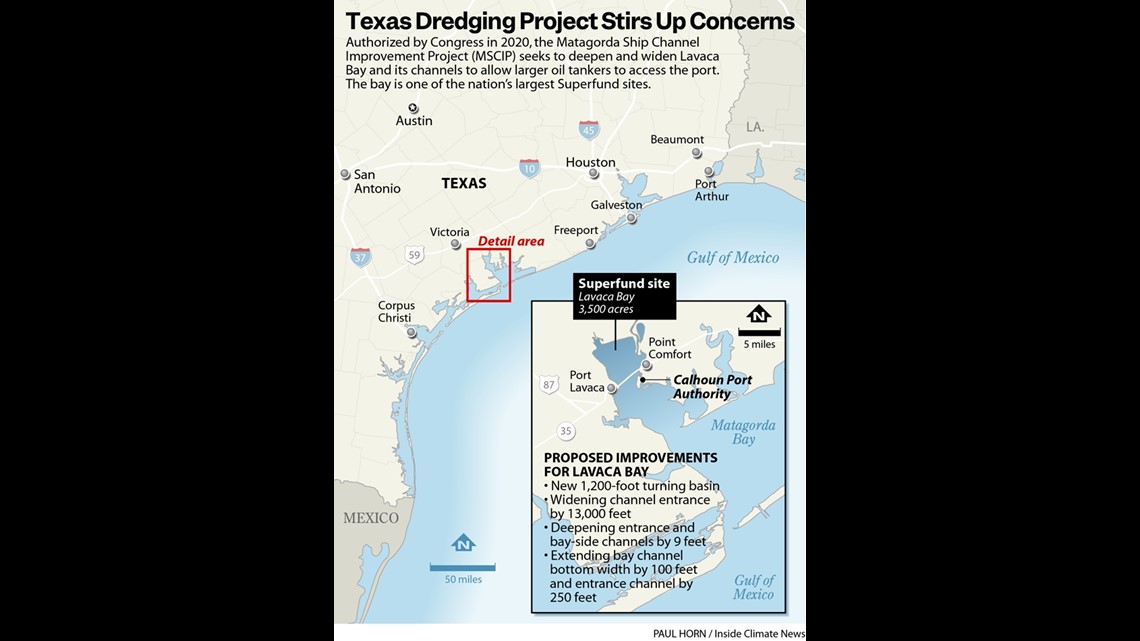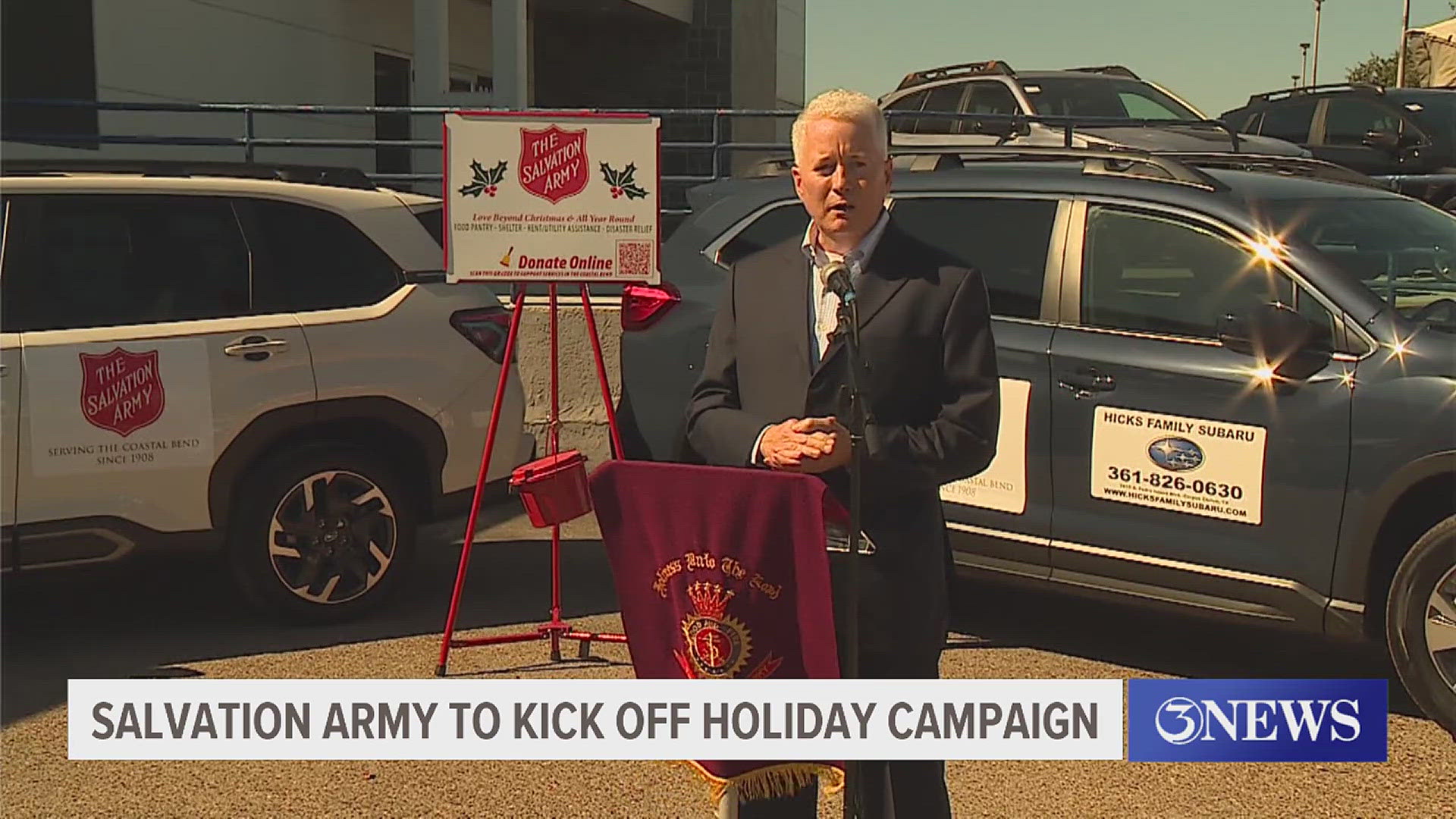This article originally appeared on Inside Climate News, a nonprofit, independent news organization that covers climate, energy and the environment. It is republished with permission. Sign up for their newsletter here.
The Army Corps of Engineers has reversed its decision to dredge the Matagorda Bay Ship Channel through a federal Superfund site on the Texas coast midway between Galveston and Corpus Christi.
The withdrawal of the Army’s 2020 ruling, announced in a court filing last week, follows a legal challenge this year by Earthjustice, an environmental nonprofit, and a coalition of community leaders.
The opponents argued that the project—a 27-mile canal expansion designed to bring Suezmax oil tankers to expanded export terminals at Port Calhoun—would stir up mercury and other toxins in Lavaca Bay, off the ship channel.
Lavaca Bay was designated as a Superfund hazardous waste site in the 1990s after a now-idled Alcoa aluminum and chlor-alkali plant released an estimated 1.2 million pounds of mercury into its waters from 1966 to 1979.
Following the challenge by Earthjustice, a review by the Corps of Engineers found “discrepancies” in the dredging volumes calculated across its various studies, prompting a revocation of approval for a project that’s been in the works for a decade.
“It was the most amazing surprise,” said Diane Wilson, a fourth-generation shrimper and oysterwoman who had fought against the project.
After years of little response to their campaign against the plans, Wilson said she and other community leaders were shocked at the abrupt reversal.
Thirteen years have passed since the Corps issued its environmental study of the “Matagorda Ship Channel Improvement Project,” which is designed to allow the world’s largest oil tankers to access the sleepy refinery towns along the inner coast of Matagorda Bay and its inlet, Lavaca Bay.


The Alcoa (Point Comfort)/Lavaca Bay Superfund site, one of the largest in the nation, covers 3,500 acres and includes the closed aluminum plant, several interconnected bays and a toxic waste dumping ground called Dredge Island. The Corps’ expansion of the Matagorda Bay Ship Channel would have dredged through this site, churning up mercury that had been compressed by mud along with other toxins, environmental activists had argued.
In a legal notice filed on Dec. 15 in U.S. District Court, the Corps of Engineers said that its pre-construction engineering and design had produced different estimates for the volume of bayfloor to be dredged than they had considered in their initial review.
“Due to the discrepancy in dredged material quantities,” Michael Connor, an Army assistant secretary, wrote in a Dec. 5 letter, “I am withdrawing the Record of Decision.”
The bays have been home to generations of shrimpers, oystermen and crabbers whose once-thriving businesses have struggled to make a comeback after the mercury pollution and, later, the plastics contamination of Lavaca Bay by Formosa Plastics Corp.
Previous cleanup efforts by the EPA have removed more than 400,000 cubic yards of mercury-contaminated sediment from the site.
However, EPA testing continues to show high levels of mercury in local red drum fish, suggesting ample toxins still lie buried near the area the Corps of Engineers planned to dredge.
“It is such a bad idea on so many levels,” said Erin Gaines, Earthjustice’s senior attorney., “Impacts to the bay, the health of the people, the marine environment—the fact that they would be doing all of that harm for an oil export facility.”
Midstream LLC had plans to develop infrastructure at Port Calhoun dependant on the deepened channel to create a major crude oil export hub.
The company said it would spend $1 billion to develop the Seahawk Terminal at the port to reach a capacity of about 670,000 barrels per day exported through the terminal.
It’s part of the ongoing export boom along the Gulf Coast. Since Congress lifted the oil export ban in 2015, more and more petroleum produced in Texas’ Eagle Ford and Permian Basin shale fields has headed to the coast for export, and developers are rapidly expanding infrastructure to keep pace.
Gaines said she and other advocates had sent letters and reports to the Corps pointing out flaws in its environmental evaluation of the project. The lawsuit was only filed in May as a last resort when it became clear the Corps was moving forward with the project, she said.
“The Project will dredge through a mercury-contaminated Superfund Site, yet the Corps did not undertake additional testing,” the lawsuit said. “The Corps also significantly underestimated or ignored the extent of harm to important fisheries, aquatic habitats and human health.”
According to the lawsuit, the Corps had responded to public comments about the risks of dredging mercury-laden sites by ordering additional sediment testing, but only after its environmental impact study had been published and the project had been authorized.
At that point the Corps ordered a second “supplementary” environmental impact statement.
The Corps’ Dec. 13 court filing said its withdrawal of approval was based on that supplementary statement. In response to a query, the Corps said it could not comment on matters of pending litigation.
“I honestly could not wrap my brain around the fact that we were even considering dredging a site that is known to have mercury in it,” said Joanie Steinhaus, Gulf Program director at the Turtle Island Restoration Network. “How do we know that humans and wildlife aren’t going to be exposed to that?”
While activists celebrate the Corps’ reversal of its previous decision, they don’t think the struggle is over.
“If the plan continues to move forward, we will continue to fight it,” Steinhaus said. “In the billions of dollars of profit they are making, they need to stop and realize they are killing our planet.”
For Wilson, the activist shrimper, this fight is part of a last-ditch effort to save the waters whose bounties of shellfish supported her own parents and grandparents on the rugged bays and estuaries of the Texas Gulf Coast.
Through the years, industrial development, freshwater consumption and pollution have battered the vitality of the bay. The shrimp are basically gone, Wilson said, and the oysters are in critical condition.
“People are desperate,” she said. “Fishermen are not known for being outspoken activists, but they showed up for this.”
Wilson had organized the fishing families. She had gone on hunger strike for 34 days over the project, and was arrested at a protest outside the Corps of Engineers office in Galveston.
Through all of it, she said, she had barely managed to get a response. The recent reversal of the Corps’ decision, she said, was a major victory for the movement.
“Your home is sacred. And you draw a line and nobody crosses it,” Wilson said. “If you have a bay system where you shrimp or oyster, and that gets contaminated, it will destroy the entire market.”



